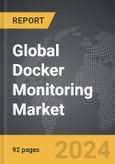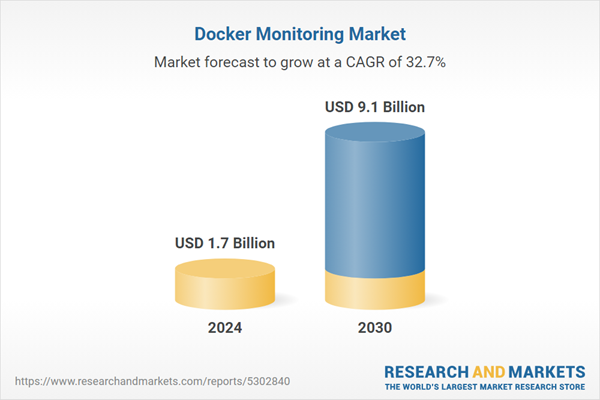Global Docker Monitoring Market - Key Trends & Drivers Summarized
How Is Docker Monitoring Transforming Application Management and Deployment?
Docker monitoring is revolutionizing application management by providing real-time visibility into containerized applications, which enables organizations to track performance, manage resources, and troubleshoot issues in complex microservices environments. With Docker, applications are broken down into smaller, isolated components called containers, which allow for consistent and efficient deployment across different computing environments. Docker monitoring tools track container performance metrics, such as CPU usage, memory consumption, and network activity, offering insights that help developers optimize resources, prevent bottlenecks, and ensure reliable application performance. This is especially valuable in modern, distributed cloud environments where applications run across multiple containers and need to function seamlessly under variable loads.The ability to monitor Docker containers is essential for maintaining operational efficiency, as it enables teams to identify issues before they impact end users. Monitoring solutions offer real-time alerts and automated responses to anomalies, reducing downtime and supporting continuous delivery practices. As microservices architectures and containerized applications become the industry standard, Docker monitoring is integral to managing the complexities of these environments. By providing deep insights into application performance, Docker monitoring enhances operational reliability and supports agile software development, making it a critical component of DevOps workflows.
What Role Do AI and Machine Learning Play in Docker Monitoring?
AI and machine learning are enhancing Docker monitoring by enabling predictive analytics, anomaly detection, and automated troubleshooting within container environments. Machine learning algorithms can analyze historical and real-time data from containers to identify patterns that signal potential performance issues, allowing teams to take proactive measures before problems escalate. For instance, AI-driven monitoring tools can recognize unusual patterns in CPU or memory usage and automatically allocate resources or restart containers to prevent service disruption. This predictive capability is invaluable in dynamic cloud environments, where application performance can fluctuate significantly based on demand.Machine learning also enables intelligent anomaly detection, alerting teams to irregular behavior that may indicate security threats, resource mismanagement, or unexpected application behavior. By integrating AI-driven insights into Docker monitoring, organizations can automate routine maintenance tasks, reduce false positives, and optimize container resource allocation in real time. These technologies provide DevOps teams with advanced tools to manage complex microservices environments, ensuring that containerized applications run smoothly and efficiently, even as demands fluctuate. As AI and machine learning continue to evolve, they are expected to play an increasingly important role in the automation and scalability of Docker monitoring solutions.
Why Is Docker Monitoring Essential in Microservices and Cloud Environments?
Docker monitoring is essential in microservices and cloud environments because it provides the visibility and control needed to manage the highly distributed, dynamic nature of these architectures. In a microservices setup, applications are composed of multiple containers, each responsible for a specific function, which communicate with each other over the network. Monitoring is critical to ensure each container performs optimally, as any disruption in one container can impact the entire application. Docker monitoring allows teams to oversee resource usage, application dependencies, and communication pathways, helping identify and address potential issues quickly.In cloud environments, where applications often scale up or down based on demand, Docker monitoring ensures that resources are used efficiently. Cloud-native applications rely heavily on containers, and monitoring solutions allow teams to track metrics like load balancing, response times, and service availability, ensuring that containerized applications meet performance expectations. By providing insights into the health and efficiency of containers, Docker monitoring enables proactive management, ensuring consistent performance across distributed environments and supporting high availability, scalability, and cost efficiency in cloud-based applications.
What Is Driving Growth in the Docker Monitoring Market?
The growth in the Docker monitoring market is driven by several factors, including the widespread adoption of containerized applications, the rise of microservices architecture, and the increasing reliance on cloud computing. As organizations shift to containerization and microservices for flexible, scalable application development, Docker monitoring tools have become essential for maintaining application performance and ensuring efficient resource allocation. The growing demand for agile software development practices, particularly DevOps, has further fueled the adoption of Docker monitoring, as these tools support continuous delivery and enable real-time performance tracking.Technological advancements, such as AI-driven analytics and automation in monitoring solutions, are enhancing the capabilities of Docker monitoring, making it easier for organizations to manage complex container environments. Additionally, the increasing use of multi-cloud and hybrid cloud environments has created a need for monitoring solutions that provide visibility across distributed cloud infrastructures. With Docker monitoring, organizations can ensure that containerized applications remain stable, secure, and efficient, even in highly dynamic cloud environments. As containerization and cloud adoption continue to grow, the Docker monitoring market is expected to expand, offering organizations the tools needed to manage modern, distributed application architectures effectively.
Report Scope
The report analyzes the Docker Monitoring market, presented in terms of market value (US$ Thousand). The analysis covers the key segments and geographic regions outlined below.- Segments: Component (Services, Solutions); Vertical (IT & Telecom, BFSI, eCommerce & Retail, Media & Entertainment, Travel & Hospitality, Healthcare & Life Sciences, Other Verticals).
- Geographic Regions/Countries:World; United States; Canada; Japan; China; Europe (France; Germany; Italy; United Kingdom; Spain; Russia; and Rest of Europe); Asia-Pacific (Australia; India; South Korea; and Rest of Asia-Pacific); Latin America (Argentina; Brazil; Mexico; and Rest of Latin America); Middle East (Iran; Israel; Saudi Arabia; United Arab Emirates; and Rest of Middle East); and Africa.
Regional Analysis
Gain insights into the U.S. market, valued at $409.7 Million in 2024, and China, forecasted to grow at an impressive 40.5% CAGR to reach $2.8 Billion by 2030. Discover growth trends in other key regions, including Japan, Canada, Germany, and the Asia-Pacific.Why You Should Buy This Report:
- Detailed Market Analysis: Access a thorough analysis of the Global Docker Monitoring Market, covering all major geographic regions and market segments.
- Competitive Insights: Get an overview of the competitive landscape, including the market presence of major players across different geographies.
- Future Trends and Drivers: Understand the key trends and drivers shaping the future of the Global Docker Monitoring Market.
- Actionable Insights: Benefit from actionable insights that can help you identify new revenue opportunities and make strategic business decisions.
Key Questions Answered:
- How is the Global Docker Monitoring Market expected to evolve by 2030?
- What are the main drivers and restraints affecting the market?
- Which market segments will grow the most over the forecast period?
- How will market shares for different regions and segments change by 2030?
- Who are the leading players in the market, and what are their prospects?
Report Features:
- Comprehensive Market Data: Independent analysis of annual sales and market forecasts in US$ Million from 2024 to 2030.
- In-Depth Regional Analysis: Detailed insights into key markets, including the U.S., China, Japan, Canada, Europe, Asia-Pacific, Latin America, Middle East, and Africa.
- Company Profiles: Coverage of players such as Appdynamics, BMC Software, Broadcom, Centreon, Datadog and more.
- Complimentary Updates: Receive free report updates for one year to keep you informed of the latest market developments.
Some of the 36 companies featured in this Docker Monitoring market report include:
- Appdynamics
- BMC Software
- Broadcom
- Centreon
- Datadog
- Dynatrace
- IBM Corporation
- Instana
- Manageengine
- Micro Focus
- Microsoft Corporation
- New Relic
- Oracle Corporation
- Right to Win
- Riverbed Technology
- Sciencelogic
- Solarwinds
- Splunk
- Sumo Logic
- Sysdig, Inc.
- Wavefront (By Vmware)
This edition integrates the latest global trade and economic shifts into comprehensive market analysis. Key updates include:
- Tariff and Trade Impact: Insights into global tariff negotiations across 180+ countries, with analysis of supply chain turbulence, sourcing disruptions, and geographic realignment. Special focus on 2025 as a pivotal year for trade tensions, including updated perspectives on the Trump-era tariffs.
- Adjusted Forecasts and Analytics: Revised global and regional market forecasts through 2030, incorporating tariff effects, economic uncertainty, and structural changes in globalization. Includes historical analysis from 2015 to 2023.
- Strategic Market Dynamics: Evaluation of revised market prospects, regional outlooks, and key economic indicators such as population and urbanization trends.
- Innovation & Technology Trends: Latest developments in product and process innovation, emerging technologies, and key industry drivers shaping the competitive landscape.
- Competitive Intelligence: Updated global market share estimates for 2025, competitive positioning of major players (Strong/Active/Niche/Trivial), and refined focus on leading global brands and core players.
- Expert Insight & Commentary: Strategic analysis from economists, trade experts, and domain specialists to contextualize market shifts and identify emerging opportunities.
Table of Contents
Companies Mentioned (Partial List)
A selection of companies mentioned in this report includes, but is not limited to:
- Appdynamics
- BMC Software
- Broadcom
- Centreon
- Datadog
- Dynatrace
- IBM Corporation
- Instana
- Manageengine
- Micro Focus
- Microsoft Corporation
- New Relic
- Oracle Corporation
- Right to Win
- Riverbed Technology
- Sciencelogic
- Solarwinds
- Splunk
- Sumo Logic
- Sysdig, Inc.
- Wavefront (By Vmware)
Table Information
| Report Attribute | Details |
|---|---|
| No. of Pages | 282 |
| Published | December 2025 |
| Forecast Period | 2024 - 2030 |
| Estimated Market Value ( USD | $ 1.7 Billion |
| Forecasted Market Value ( USD | $ 9.1 Billion |
| Compound Annual Growth Rate | 32.7% |
| Regions Covered | Global |









